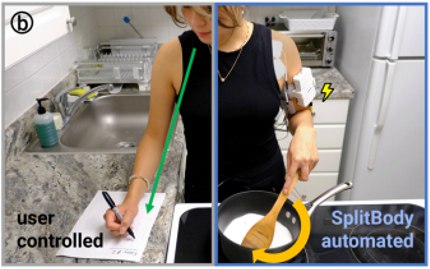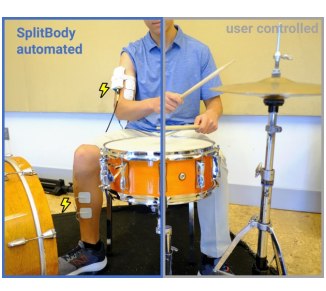| SplitBody - Using EMS To Free Your Mind |
| Written by Lucy Black | |||
| Sunday, 02 June 2024 | |||
|
Can automating a repetitive movement via electrical muscle stimulation reduce mental workload while users concurrently perform an unrelated task? The SplitBody research study from the University of Chicago's Human Computer Integration Lab shows that, yes, it can. I Programmer first reported on electrical muscle stimulation (EMS), which works by delivering tiny electrical pulses through electrodes placed on the skin to trigger the motor nerves, over a decade ago. It is still relatively new technology and is under active investigation by research groups. The methodology and outcomes of a novel study were presented at the ACM CHI 2024 conference held in Honolulu, Hawaii by Romain Nith, Yun Ho and Pedro Lopes, winning them a Best Paper Award for "SplitBody: Reducing Mental Workload while Multitasking via Muscle Stimulation". Explaining the split-body approach, the paper states that whereas interactive-actuation systems, such as EMS, are usually used to assist tasks like shaking a spray can that users are actually focusing on, in this case the idea is to investigate whether they offer any benefits if they automate a task that happens in the background of the user’s focus - for example having the repetitive action of stirring a pan aided by the EMS SplitBody device while paying attention to the cognitive task of writing an essay. For the central experiment using SplitBody the researchers recruited 12 participants to engage in a multitask, a cognitive load test combined with a repetitive sequence of movements. The first hypothesis to be tested was that SplitBody’s ability to automate one of the tasks would result in a decreased mental workload and the second hypothesis was that this would lead to improved performance on both aspects of the multitask. The results, which compared baseline performance without any EMS assistance with SplitBody-aided performance in which movement task was automated confirmed both hypotheses.
The video has more details In addition to Split-Chef which involved essay writing at the same time as stirring a pan automated by the EMS device, other applications are presented in the video. Split-draw requires users to simultaneously draw a sketch with their dominant hand while shading (coloring in) with the other hand under SplitBody control. In Split-Drum, a novice learns to play a drum kit with the SplitBody device controlling on of his legs to plays the bass & hi-hat one hand while he is pays attention to playing the snare at the correct timings. Handing parts of you body off to computer control seems to lower the cognitive load, leaving your brain to do something else. This is a very strange, bizarre even, form of automation. What next? Couple it with AI or brain implants? Rent out parts of your body for use by a third party? Or is this a solution looking for a problem. More InformationSplitBody: Reducing Mental Workload while Multitasking via Muscle Stimulation (plopes.org) Related ArticlesMuscle Input Device Getting Ready To Ship Myoelectric Input - Better Than Kinect? To be informed about new articles on I Programmer, sign up for our weekly newsletter, subscribe to the RSS feed and follow us on Twitter, Facebook or Linkedin.
|
|||
| Last Updated ( Sunday, 02 June 2024 ) |



